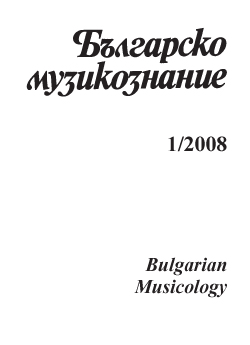Новата музика в хоризонта на двата водещи тематични проекта на модерността: фрагменти
New Music on the Horizon of Two Leading Thematic Projects of Modernity: Fragments
Author(s): Tsenka Yordanova Subject(s): Music
Published by: Институт за изследване на изкуствата, Българска академия на науките
Summary/Abstract: The subject of this study is New Music from the 20th century (Musica Nova or Neue Musik) in the Austrian and German context around the First World War: before the war, in the context of Viennese modernism, and after the war, in the context of Berlin modernity. The basis for my observations is work on the deconstruction of tonality and the appearance of the chromatic tone row - a type of Opus Magnum in the field of “the being of sense and meaning” of the New in music. This act, which forms the basis of uncompromising Neue Musik, is examined here within the horizon of the two major leading thematic projects of Modernity: the Cartesian and the interpretative. The impact of the first thematic project - the Cartesian objectifying experimentalmathematic project of Modernity - has activated the processes. Within the framework of Neue Musik it was actualized after 1908 in a relatively pure form by Josef Matt hias Hauer, who called himself a “musical engineer.” His bipolar yin/yang system of 44 tropes (groups) of 12 tones, each of which was divided into two polar groups of six tones - as well as his new system of notation without alterations, suitable for free work across the whole tonal row – are examined in this study as a thoroughly rationalized analytical-theoretical mode of the Cartesian objectifying project of Modernity applied to the languages and codes of Neue Musik. The experiment and its place in the work of the musical avant-garde in the second half of the 20th century is also a fact in the horizon of experimental-mathematical thematization through the objectifying Cartesian project of physical/acoustic reality. The impact of the second thematic project - the alternative critical interpretive humanistic project of Modernity - is realized by the Circle of Schoenberg, Webern and Berg. The new objectifi cation and the new expressivity of Neue Musik has been radically rethought on the musical-artistic level; the atonalsystematization of musical codes and languages has evolved more slowly and gradually in comparison to Hauer’s “engineering” style of thinking, developing the twelve-tone music as if it were organic material. Existing in its own reality of an intentionally created hermeneutic universum, Musica Nova is the result of complex internal interferences and mutual interaction between these two mega-projects of Modernity and their impact on the “lived world” of modern musicality: from the most intimate mechanisms of Neue Musik’s acoustic parameters to the existence of its meaning and its substantiality. And its comprehensibility (Fasslichkeit) or coherence (Zusammenhang).
Journal: Българско музикознание
- Issue Year: 2008
- Issue No: 1
- Page Range: 62-89
- Page Count: 28
- Language: Bulgarian
- Content File-PDF

